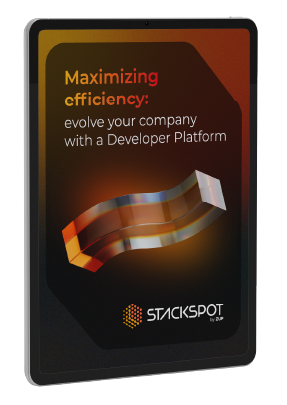Note: This blog post was created by the StackSpot Prompt Engineering team with the support of AI tools. This content underwent rigorous review for technical accuracy, content relevance, and well-written quality before its publication. Enjoy the read!
In today’s rapidly evolving digital landscape, organizations are constantly challenged to keep up with technological advancements while maximizing the efficiency and effectiveness of their existing systems. Legacy software modernization has emerged as a critical initiative for Chief Information Officers (CTOs) to revolutionize their technology infrastructure and stay ahead of the competition.
This blog post will explore the essential tools that CTOs can leverage to catalyze legacy software modernization, providing valuable insights and strategies to optimize your organization’s technology infrastructure.
The Need for Legacy Software Modernization
To thrive in a digital-first world, organizations must address the limitations and challenges posed by legacy systems. Legacy software modernization involves upgrading or replacing outdated technology and processes to meet the demands of the modern business landscape. This strategic imperative enables organizations to enhance agility, improve customer experience, reduce costs, and drive innovation.
The Impact of Legacy Systems on Business Agility
Legacy systems often lack the flexibility and scalability to adapt to rapidly changing business needs. The inability to integrate with new technologies and leverage data-driven insights hinders business agility and slows down processes. By embracing legacy software modernization, CTOs can empower their organizations to respond swiftly to market demands, drive innovation, and gain a competitive advantage.
Essential Tools for Legacy Software Modernization
1 – Comprehensive Legacy Assessment
Before embarking on any modernization journey, CTOS must conduct a comprehensive legacy assessment. This involves evaluating existing systems, identifying pain points, and understanding business requirements. By gaining a holistic view of the current technology landscape, CTOs can make informed decisions and prioritize modernization efforts effectively.
2 – Application Portfolio Rationalization
Legacy modernization often involves a complex mix of systems, applications, and processes. CTOs need to analyze their application portfolios to identify redundancies, dependencies, and opportunities for consolidation. This rationalization process enables organizations to streamline their technology stack, reduce maintenance costs, and improve efficiency.
3 – Cloud Migration Strategy
Cloud computing has revolutionized the way organizations manage their technology infrastructure. CTOs need to develop a robust cloud migration strategy to leverage cloud platforms’ scalability, flexibility, and cost-efficiency. By migrating legacy systems to the cloud, organizations can modernize their infrastructure, enhance data security, and gain access to a wide range of advanced services and tools.
4 – Agile Development Methodologies
Implementing agile development methodologies is essential for successful legacy modernization. By adopting iterative and collaborative approaches such as Agile or DevOps, CTOs can accelerate the modernization process, increase stakeholder engagement, and ensure seamless integration of new technologies. Agile methodologies enable organizations to deliver value incrementally, mitigate risks, and achieve faster time-to-market.
5 – Robust Change Management Processes
Legacy modernization initiatives often face resistance and skepticism from stakeholders due to the perceived risks and disruptions. CTOs must establish robust change management processes to address these concerns effectively. Organizations can ensure smooth transitions, minimize resistance, and maximize the benefits of legacy modernization by fostering a culture of transparency, communication, and collaboration.
6 – Data Migration and Integration Tools
Legacy modernization involves migrating and integrating vast data from legacy systems to modern platforms. CTOs must invest in robust data migration and integration tools that enable seamless data transfer while maintaining data integrity and security. These tools facilitate data consolidation from disparate sources, ensuring a unified and accurate view of information across the organization.
The Road Ahead: Overcoming Challenges
Legacy software modernization has its challenges. CTOs must be prepared to address potential roadblocks and navigate complexities to ensure successful outcomes. Some common challenges include:
- Budget constraints and resource limitations
- Legacy system dependencies and integrations
- Data security and privacy concerns
- Resistance to change from stakeholders
- Legacy system documentation and knowledge transfer
By proactively acknowledging and addressing these challenges, CTOs can pave the way for a smooth and successful legacy modernization journey.
Conclusion
Legacy software modernization is a critical initiative for CTOs to transform their organization’s technology infrastructure and unlock new opportunities for growth and innovation. By leveraging the essential tools discussed in this blog post, CTOs can overcome challenges, drive agility, and optimize their technology landscape. Embracing legacy modernization is a strategic imperative and a catalyst for success in today’s digital landscape.
Remember, legacy modernization is not a one-time endeavor but an ongoing process. Staying ahead of the curve requires continuous evaluation, adaptation, and innovation. As a CIO, you are responsible for championing legacy modernization and leading your organization toward a future-ready technology ecosystem. Embrace the tools, strategies, and insights shared in this blog post, and confidently embark on your legacy software modernization journey.
Unlock the power of Legacy Modernization with StackSpot!
Are you navigating the intricate maze of legacy modernization? Discover how StackSpot helps with this process.
Seamlessly integrate new-age technologies, benefit from tailored automation, and leverage AI-driven insights to transform your legacy systems. Don’t just modernize… revolutionize!
Dive into StackSpot now and be the catalyst for your company’s digital metamorphosis. Explore StackSpot today!












